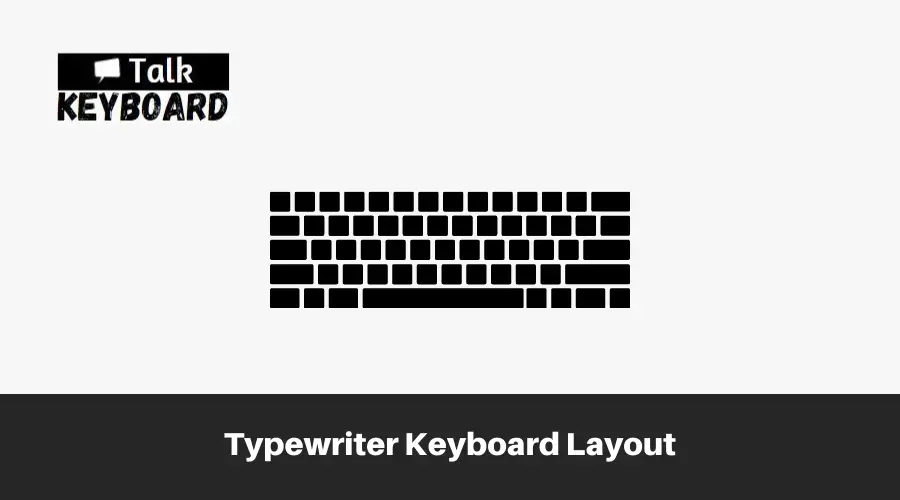The typewriter keyboard layout, or the QWERTY layout, is used in traditional typewriters and computer keyboards. It arranges keys to prevent mechanical jams and optimize typing efficiency.
Despite being invented over a century ago, the typewriter keyboard layout continues to be widely used in the digital era. It helps by providing familiarity to users, enabling muscle memory for faster typing, and ensuring compatibility across devices and software. Also, it offers a standardized typing experience.
While alternative layouts have been proposed, the typewriter keyboard layout persists due to its historical prevalence and the challenges associated with transitioning to a new arrangement.

What is the typewriter keyboard layout?
The typewriter keyboard layout is used on traditional typewriters and early computer keyboards. It consists of a QWERTY arrangement of keys named after the first six letters in the top row.
Invented by Christopher Latham Sholes, it was patented in 1878. Sholes and his associates developed this layout to prevent mechanical jams in typewriters. By strategically positioning frequently used letters apart, they aimed to reduce the likelihood of adjacent keys jamming when pressed quickly in succession.
Sholes intended it to increase typing efficiency and minimize the need for frequent repairs, which were common in early typewriters.
Despite claims that it was not optimal for speed or ergonomics, the QWERTY layout gained popularity and became widely adopted. Today, it remains the standard layout for keyboards in many countries.
Why is Typewrite Keyboard Layout Popular?
Although typewriter keyboard layout was invented over 100 years ago, it remains popular for several reasons.
1. Historical Prevalence
The typewriter keyboard layout gained widespread adoption during the early days of typewriters and continued to be used when computers were introduced. Its familiarity and ubiquity have contributed to its enduring popularity.
2. QWERTY Design
The QWERTY layout is designed to prevent key jams. Frequently used letters are strategically placed apart to reduce the likelihood of adjacent keys jamming when pressed quickly in succession.
4. Compatibility
The QWERTY layout is compatible with a wide range of devices and software. It has become a standard that manufacturers and developers adhere to, ensuring compatibility across different platforms.
5. Resistance to Change
Despite claims of more efficient layouts, the QWERTY design has persisted due to the resistance to change and the high cost associated with transitioning to a new layout. The inertia of the status quo has allowed the QWERTY layout to maintain its popularity.
How is the typewriter keyboard layout used in the digital era?
The typewriter keyboard layout continues to be widely used in the digital era, primarily in computer keyboards and mobile devices.
- Computers: The QWERTY layout is the standard for computer keyboards globally. It is compatible with various operating systems, software, and applications. Its familiarity and muscle memory make it convenient for users to type efficiently.
- Laptops: Laptop keyboards follow the QWERTY layout, allowing users to type and input commands seamlessly. The layout’s compatibility ensures that laptop users can easily transition from desktop computers.
- Mobile Devices: Virtual keyboards on smartphones and tablets emulate the QWERTY layout, adapting it to touchscreens. Users can type on a digital keyboard that mirrors the physical arrangement of a typewriter, promoting ease of use and familiarity.
What are the Advantages and Disadvantages of typewriter keyboard layout?
The QWERTY layout provides benefits such as familiarity, muscle memory, and standardized typing experiences.
Advantages:
- Familiarity: The typewriter keyboard layout is widely recognized and familiar to users, making it easy to transition between devices.
- Muscle Memory: Many individuals have developed muscle memory for the QWERTY layout, allowing faster and more accurate typing.
- Compatibility: The QWERTY layout is compatible with various devices, operating systems, and applications, ensuring seamless integration.
- Standardization: The typewriter keyboard layout has become a global standard, enabling consistent user experiences and reducing the need for adaptation.
- Multilingual Support: The QWERTY layout has been adapted to support multiple languages, providing a common foundation for typing across different language inputs.
Disadvantages
- Efficiency: Some argue that the QWERTY layout could be more efficient, as it was designed to prevent key jams rather than optimize typing speed and ergonomics.
- Ergonomics: The typewriter keyboard layout may not be ergonomically optimized, potentially leading to discomfort or repetitive strain injuries with prolonged use.
FAQ
Typewriter keys in a keyboard refer to the physical keys that resemble those found on traditional typewriters. These keys are used for inputting characters and commands. They typically have a tactile feel and produce an audible click when pressed, mimicking the experience of typing on a typewriter.
The first typewriter key layout was the QWERTY layout. It was invented by Christopher Latham Sholes and patented in 1878. The QWERTY layout arranged the keys in a specific order, named after the first six letters in the top row, to prevent mechanical jams in early typewriters.
The typewriter or QWERTY keyboard layout is arranged the way it is to prevent mechanical jams in early typewriters. Frequently used letters were placed apart to reduce the likelihood of adjacent keys jamming when pressed quickly in succession, improving typing efficiency and reducing the need for repairs.
Christopher Latham Sholes invented the typewrite or QWERTY keyboard layout. He and his associates developed the QWERTY layout and patented it in 1878. Sholes was a newspaper editor and printer who aimed to address the mechanical jamming issues in early typewriters with this keyboard design.
Final Words
The typewriter keyboard layout, particularly the QWERTY design, remains favored for several reasons.
Its historical prevalence, compatibility, and resistance to change have contributed to its enduring popularity. However, digital technologies have changed the typing experience in the modern era.
While the physical typewriter is less commonly used today, the QWERTY layout has seamlessly transitioned into computer keyboards and mobile devices. The layout continues to shape the typing experience, offering convenience, efficient input, and multilingual support.
Overall, it connects the past with the present in the evolution of typing.

I am a regular user of computer keyboards. For using keyboard face different kinds of problems and also solve it very easily. I love sharing knowledge about keyboards.
